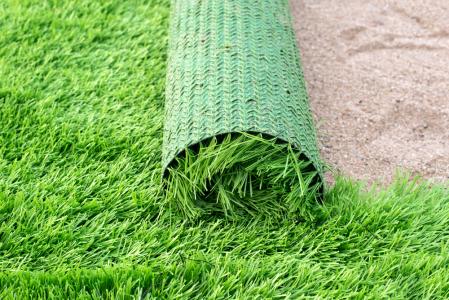
Is a “Fake” Lawn Right for You?
Synthetic grass has come a long way since it first appeared in the mid-1960s. Today, substantial product improvements have made it difficult, in many cases, to spot a manufactured lawn.
Homeowners are using artificial turf for many different applications, including lawns, play areas, dog runs, putting greens, pool surrounds, and more.
It can be a particularly appropriate choice in arid climates where grass lawns aren’t practical, as well as other areas facing water restrictions.
If you’re wondering if synthetic turf is a good choice for your home, consider these pros and cons:
PRO: It requires less maintenance.
There’s no need to hire a lawn crew or do your own mowing, trimming, and weeding. You also won’t have to invest any time or money on fertilizers or reseeding trouble spots.
Synthetic lawns also demand no watering requirements (unless you have a dog run), further reducing chores and costs.
Artificial turf’s maintenance-free benefits extend into your home since no mud will be tracked into the house.
CON: It’s not entirely maintenance free.
Leaves from nearby bushes and trees will still accumulate on an artificial lawn. If you don’t remove them, weeds can grow in the leaf debris, creating another yard chore.
If you have a dog run, you’ll still need to hose it down regularly to prevent unpleasant smells from accumulating.
PRO: It lasts a long time.
Depending on the quality of the product, artificial turf can last 15 to 25 years.
CON: It’s expensive.
Premium artificial grass can cost upwards of $20 per square foot, installed. However, once installed, it’s virtually free to maintain.
The longer you stay in your home, the faster the cost/benefit trade-offs will tip in your favor.
PRO: It offers several eco-friendly benefits.
Synthetic grass is often manufactured with partially recycled materials. Plus, you’ll never need to fire up an air-polluting gas-powered lawn mower, apply chemicals, or run a sprinkler.
CON: It’s not a perfect option for eco-minded buyers.
Turf manufacturing is not an environmentally-friendly process, and most materials cannot be recycled when it’s time for a replacement.
Heat absorption is another environmental concern, as well as radiant heat, although some products pose fewer problems than others.
PRO: It’s pet-friendly.
A turf yard can be a substantial boon for urban dog owners who are stuck taking Fido on multiple daily walks to find the nearest patch of grass. Just open the back door and conveniently scoop up any messes.
Or, if you currently have a grass lawn but are tired of fixing dead patches or worn pathways from your dog’s backyard activities, artificial turf may eliminate these chores.
CON: Not all turf products are pet-friendly.
It’s always essential to evaluate a turf manufacturer’s product features before buying. However, this is especially crucial when pets are part of the equation.
Make sure you select a product that won’t burn dogs’ sensitive paws on hot days and can hold up to heavy traffic, especially if you have a large dog that spends lots of time in the yard.
Additionally, look for proper drainage and anti-microbial features so your turf won’t trap unpleasant pet waste odors.
PRO: It’s easier than ever to pull off a “fake.”
Synthetic turf manufacturers now offer a wide variety of product heights, densities, and colors. Some synthetics even include a shorter, contrasting thatch layer that helps turf appear less “fake.”
CON: It might not be allowed.
Even though artificial turf has grown in popularity, some homeowner’s associations (HOA) don’t allow it. If you live in a community that is governed by an HOA, check the rules before proceeding on an expensive installation that will need to be removed.
